Analys
A moment in markets – Commodity returns can be enhanced


In ‘A moment in markets – Are we in a commodity supercycle?’ the promising environment for commodities, especially sectors like industrial metals, was outlined. But for investors who endorse the case for commodities, portfolio implementation is the natural next step to ponder over. In many cases, having a pure beta exposure to commodities makes perfect sense. In some instances, however, smarter approaches present viable alternatives.
The return breakdown
Investors who are not interested in storing physical commodities are likely to seek synthetic exposures to the asset class. Exchange-traded commodity products are either physically-backed or synthetic, i.e., exposed to futures. When it comes to commodity futures exposure, the total return to investors is as follows:

To avoid getting physical delivery of commodities upon expiry of the futures contract, investors maintain their exposure by rolling their futures position to a contract with later maturity. This process can incur a carry return because futures prices may converge to spot prices over time, i.e., there is a gain or loss in carrying the futures contract up or down the curve. When futures curves are in contango, i.e., prices are upward sloping, roll yield is typically negative and when curves are in backwardation, i.e., prices are downwards sloping, roll yield is typically positive.
A pure beta approach would normally provide exposure to contracts towards the front end of the futures curve. Such strategies tend to do well relative to those that are exposed to contracts further out along the futures curve when commodity prices are in a bull run and the spot return component is dominating total returns. This is because contracts at the front end are closer to the spot price and normally experience higher price fluctuation than those further along the curve. The roll return will, however, depend on the shape of the futures curve.
Optimizing the roll return
In contrast to the front-month approach, a dynamic approach to selecting futures contracts that promises a potentially better roll yield can add incremental value to total returns over a longer period. For example, the Bloomberg Commodity Index (BCOM) approach invests in contracts towards the front end of the futures contract.
In figure 1 the case of aluminium is currently the July 2021 contract. In contrast, the S&P GSCI Aluminium Dynamic Roll Index, which reassesses its exposure monthly and can go further out on the curve, is currently in the December 2022 contract.
Looking at the shape of aluminium’s futures curve, we can observe that while July 2021 faces contango, the curve is in slight backwardation around the December 2022 contract (see figure 1 below).
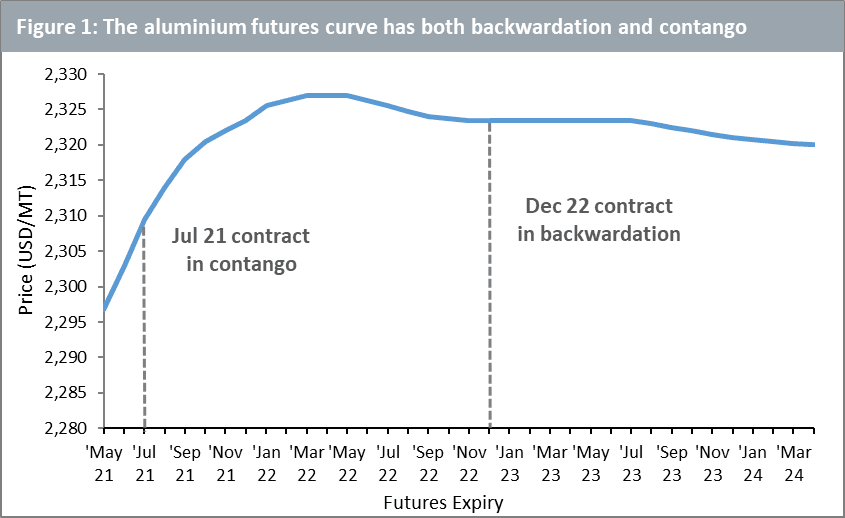
Certain approaches give exposure to specific points along the futures curve, e.g., the UBS Bloomberg Constant Maturity Commodity Index (CMCI). Each approach has its own merits and investors should take the time to familiarise themselves with the methodology.
The key distinction for a dynamic approach in the current macro environment is that sharp fluctuations in demand and supply conditions in recent months have caused futures curves to frequently change shape. Aluminium’s entire curve at the end of January was in steep contango before becoming much flatter when supply curtailment from Inner Mongolia in March tightened the market. While there is no single formula to predict which approach will outperform when, it is useful to recognise that curves can change shape, and this can have an impact on roll returns.
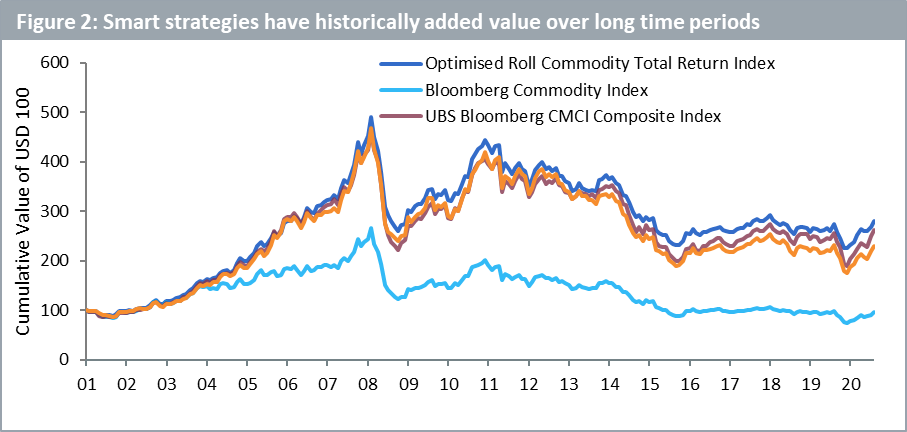
The deciding factor
With all the options available to investors, the decision comes down to whether the commodity exposure is a strategic or tactical decision. Enhanced approaches aim to add value by improving the carry return and reducing volatility – as longer tenor contracts tend to exhibit less price fluctuation compared to front-month contracts.
The true benefit of smarter approaches that seek to enhance the risk-return profile of commodities becomes apparent over longer periods (see figure 2). Enhanced approaches are, therefore, better suited to strategic investors looking for broad commodities exposure.
/Mobeen Tahir, Associate Director, Research, WisdomTree
Analys
OPEC+ in a process of retaking market share

Oil prices are likely to fall for a fourth straight year as OPEC+ unwinds cuts and retakes market share. We expect Brent crude to average USD 55/b in Q4/25 before OPEC+ steps in to stabilise the market into 2026. Surplus, stock building, oil prices are under pressure with OPEC+ calling the shots as to how rough it wants to play it. We see natural gas prices following parity with oil (except for seasonality) until LNG surplus arrives in late 2026/early 2027.

Oil market: Q4/25 and 2026 will be all about how OPEC+ chooses to play it
OPEC+ is in a process of unwinding voluntary cuts by a sub-group of the members and taking back market share. But the process looks set to be different from 2014-16, as the group doesn’t look likely to blindly lift production to take back market share. The group has stated very explicitly that it can just as well cut production as increase it ahead. While the oil price is unlikely to drop as violently and lasting as in 2014-16, it will likely fall further before the group steps in with fresh cuts to stabilise the price. We expect Brent to fall to USD 55/b in Q4/25 before the group steps in with fresh cuts at the end of the year.

Natural gas market: Winter risk ahead, yet LNG balance to loosen from 2026
The global gas market entered 2025 in a fragile state of balance. European reliance on LNG remains high, with Russian pipeline flows limited to Turkey and Russian LNG constrained by sanctions. Planned NCS maintenance in late summer could trim exports by up to 1.3 TWh/day, pressuring EU storage ahead of winter. Meanwhile, NE Asia accounts for more than 50% of global LNG demand, with China alone nearing a 20% share (~80 mt in 2024). US shale gas production has likely peaked after reaching 104.8 bcf/d, even as LNG export capacity expands rapidly, tightening the US balance. Global supply additions are limited until late 2026, when major US, Qatari and Canadian projects are due to start up. Until then, we expect TTF to average EUR 38/MWh through 2025, before easing as the new supply wave likely arrives in late 2026 and then in 2027.
Analys
Manufacturing PMIs ticking higher lends support to both copper and oil

Price action contained withing USD 2/b last week. Likely muted today as well with US closed. The Brent November contract is the new front-month contract as of today. It traded in a range of USD 66.37-68.49/b and closed the week up a mere 0.4% at USD 67.48/b. US oil inventory data didn’t make much of an impact on the Brent price last week as it is totally normal for US crude stocks to decline 2.4 mb/d this time of year as data showed. This morning Brent is up a meager 0.5% to USD 67.8/b. It is US Labor day today with US markets closed. Today’s price action is likely going to be muted due to that.

Improving manufacturing readings. China’s manufacturing PMI for August came in at 49.4 versus 49.3 for July. A marginal improvement. The total PMI index ticked up to 50.5 from 50.2 with non-manufacturing also helping it higher. The HCOB Eurozone manufacturing PMI was a disastrous 45.1 last December, but has since then been on a one-way street upwards to its current 50.5 for August. The S&P US manufacturing index jumped to 53.3 in August which was the highest since 2022 (US ISM manufacturing tomorrow). India manufacturing PMI rose further and to 59.3 for August which is the highest since at least 2022.
Are we in for global manufacturing expansion? Would help to explain copper at 10k and resilient oil. JPMorgan global manufacturing index for August is due tomorrow. It was 49.7 in July and has been below the 50-line since February. Looking at the above it looks like a good chance for moving into positive territory for global manufacturing. A copper price of USD 9935/ton, sniffing at the 10k line could be a reflection of that. An oil price holding up fairly well at close to USD 68/b despite the fact that oil balances for Q4-25 and 2026 looks bloated could be another reflection that global manufacturing may be accelerating.
US manufacturing PMI by S&P rose to 53.3 in August. It was published on 21 August, so not at all newly released. But the US ISM manufacturing PMI is due tomorrow and has the potential to follow suite with a strong manufacturing reading.
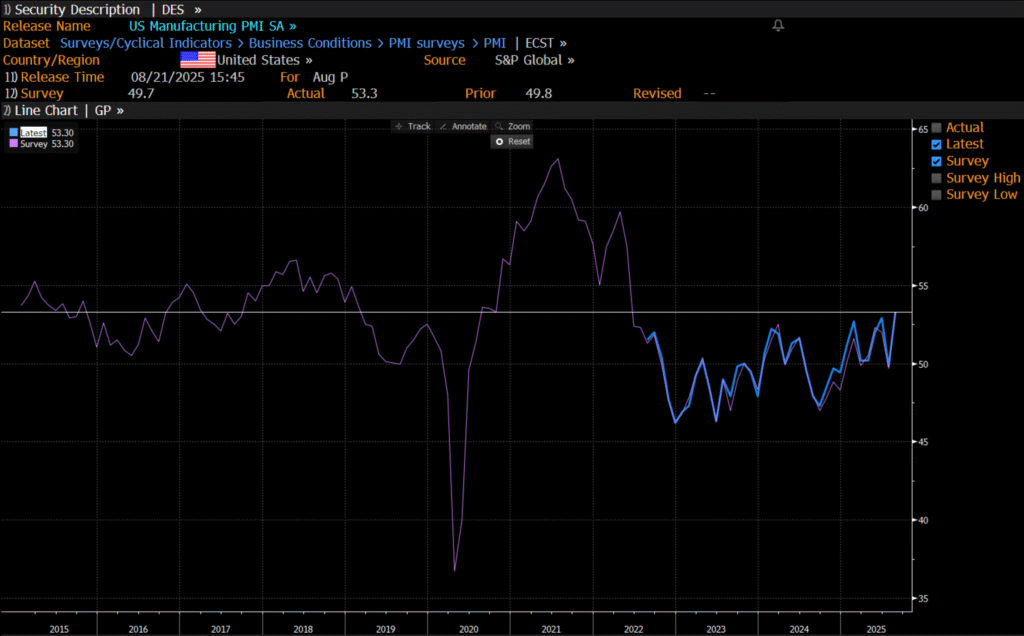
Analys
Crude stocks fall again – diesel tightness persists

U.S. commercial crude inventories posted another draw last week, falling by 2.4 million barrels to 418.3 million barrels, according to the latest DOE report. Inventories are now 6% below the five-year seasonal average, underlining a persistently tight supply picture as we move into the post-peak demand season.

While the draw was smaller than last week’s 6 million barrel decline, the trend remains consistent with seasonal patterns. Current inventories are still well below the 2015–2022 average of around 449 million barrels.
Gasoline inventories dropped by 1.2 million barrels and are now close to the five-year average. The breakdown showed a modest increase in finished gasoline offset by a decline in blending components – hinting at steady end-user demand.
Diesel inventories saw yet another sharp move, falling by 1.8 million barrels. Stocks are now 15% below the five-year average, pointing to sustained tightness in middle distillates. In fact, diesel remains the most undersupplied segment, with current inventory levels at the very low end of the historical range (see page 3 attached).
Total commercial petroleum inventories – including crude and products but excluding the SPR – fell by 4.4 million barrels on the week, bringing total inventories to approximately 1,259 million barrels. Despite rising refinery utilization at 94.6%, the broader inventory complex remains structurally tight.
On the demand side, the DOE’s ‘products supplied’ metric – a proxy for implied consumption – stayed strong. Total product demand averaged 21.2 million barrels per day over the last four weeks, up 2.5% YoY. Diesel and jet fuel were the standouts, up 7.7% and 1.7%, respectively, while gasoline demand softened slightly, down 1.1% YoY. The figures reflect a still-solid late-summer demand environment, particularly in industrial and freight-related sectors.
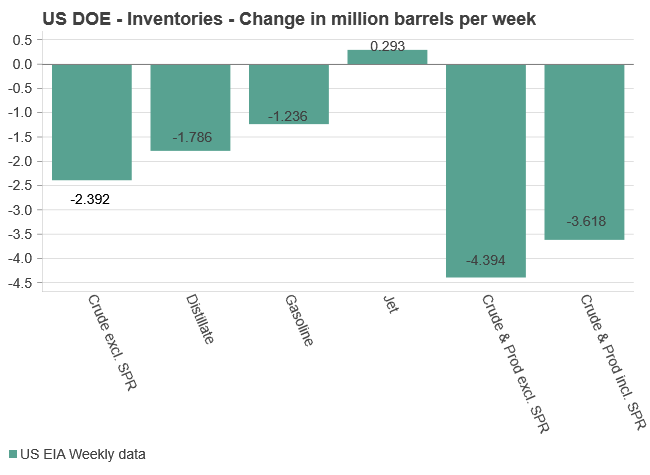
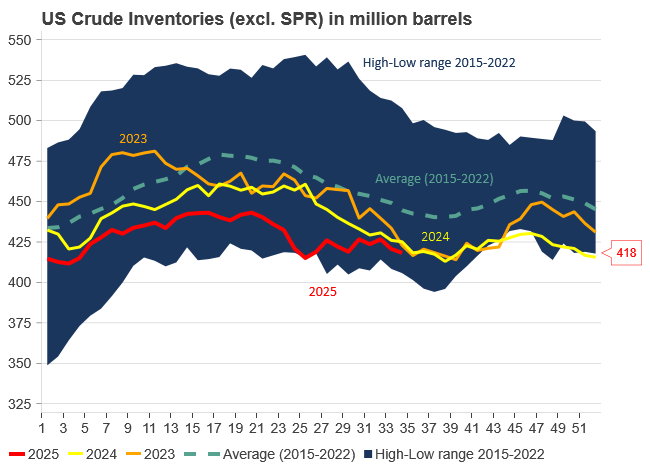
-

 Nyheter3 veckor sedan
Nyheter3 veckor sedanOmgående mångmiljardfiasko för Equinors satsning på Ørsted och vindkraft
-
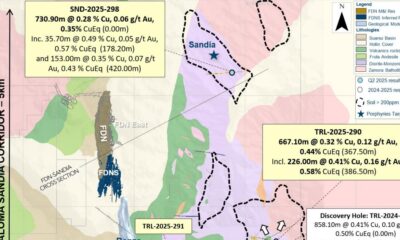
 Nyheter4 veckor sedan
Nyheter4 veckor sedanLundin Gold hittar ny koppar-guld-fyndighet vid Fruta del Norte-gruvan
-

 Nyheter2 veckor sedan
Nyheter2 veckor sedanMeta bygger ett AI-datacenter på 5 GW och 2,25 GW gaskraftverk
-

 Nyheter4 veckor sedan
Nyheter4 veckor sedanGuld stiger till över 3500 USD på osäkerhet i världen
-

 Analys3 veckor sedan
Analys3 veckor sedanWhat OPEC+ is doing, what it is saying and what we are hearing
-

 Nyheter4 veckor sedan
Nyheter4 veckor sedanAlkane Resources och Mandalay Resources har gått samman, aktör inom guld och antimon
-

 Nyheter2 veckor sedan
Nyheter2 veckor sedanAker BP gör ett av Norges största oljefynd på ett decennium, stärker resurserna i Yggdrasilområdet
-

 Nyheter4 veckor sedan
Nyheter4 veckor sedanLyten, tillverkare av litium-svavelbatterier, tar över Northvolts tillgångar i Sverige och Tyskland






